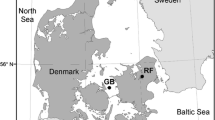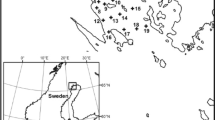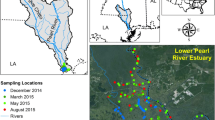Abstract
Incubation experiments were performed to examine the processing of fresh autochthonous dissolved organic matter (DOM) produced by coastal plankton communities in spring and autumn. The major driver of observed DOM dynamics was the seasonally variable inorganic nutrient status and characteristics of the initial bulk DOM, whereas the characteristics of the phytoplankton community seemed to have a minor role. Net accumulation of dissolved organic carbon (DOC) during the 18-days experiments was 3.4 and 9.2 µmol l−1 d−1 in P-limited spring and N-limited autumn, respectively. Bacterial bioassays revealed that the phytoplankton-derived DOC had surprisingly low proportions of biologically labile DOC, 12.6% (spring) and 17.5% (autumn). The optical characteristics of the DOM changed throughout the experiments, demonstrating continuous heterotrophic processing of the DOM pool. However, these temporal changes in optical characteristics of the DOM pool were not the same between seasons, indicating seasonally variable environmental drivers. Nitrogen and phosphorus availability is likely the main driver of these seasonal differences, affecting both phytoplankton extracellular release of DOM and its heterotrophic degradation by bacteria. These findings underline the complexity of the DOM production and consumption by the natural planktonic community, and show the importance of the prevailing environmental conditions regulating the DOM pathways.






Similar content being viewed by others
References
Aluwihare L, Repeta D (1999) A comparison of the chemical characteristics of oceanic DOM and extracellular DOM produced by marine algae. Mar Ecol Prog Ser 186:105–117
Amaral V, Graeber D, Calliari D, Alonso C (2016) Strong linkages between DOM optical properties and main clades of aquatic bacteria. Limnol Oceanogr 61:906–918
Asmala E, Autio R, Kaartokallio H, Pitkänen L, Stedmon C, Thomas D (2013) Bioavailability of riverine dissolved organic matter in three Baltic Sea estuaries and the effect of catchment land use. Biogeosciences 10:6969–6986
Asmala E, Autio R, Kaartokallio H, Stedmon CA, Thomas D (2014) Processing of humic-rich riverine dissolved organic matter by estuarine bacteria: effects of predegradation and inorganic nutrients. Aquat Sci 76:451
Boyd TJ, Osburn CL (2004) Changes in CDOM fluorescence from allochthonous and autochthonous sources during tidal mixing and bacterial degradation in two coastal estuaries. Mar Chem 89:189–210
Bronk DA, Glibert PM, Malone TC, Banahan S, Sahlsten E (1998) Inorganic and organic nitrogen cycling in Chesapeake Bay: autotrophic versus heterotrophic processes and relationships to carbon flux. Aquat Microb Ecol 15:177–189
Cammack W, Kalff J, Prairie YT, Smith EM (2004) Fluorescent dissolved organic matter in lakes: relationships with heterotrophic metabolism. Limnol Oceanogr 49:2034–2045
Carlson CA, Hansell DA (2014) DOM sources, sinks, reactivity, and budgets. In: Biogeochemistry of marine dissolved organic matter, Second Edition. Elsevier Inc
Chen W, Wangersky PJ (1996) Rates of microbial degradation of dissolved organic carbon from phytoplankton cultures. J Plankton Res 18:1521–1533
Coble PG (1996) Characterization of marine and terrestrial DOM in seawater using excitation-emission matrix spectroscopy. Mar Chem 51:325–346
Conley DJ, Paerl HW, Howarth RW, Boesch DF, Seitzinger SP, Havens KE, Lancelot C, Likens GE (2009) Controlling eutrophication: nitrogen and phosphorus. Science 323(5917):1014–1015
Danhiez F, Vantrepotte V, Cauvin A, Lebourg E, Loisel H (2017) Optical properties of chromophoric dissolved organic matter during a phytoplankton bloom. Implication for DOC estimates from CDOM absorption. Limnol Oceanogr 62(4):1409–1425
Flindt MR, Kamp-Nielsen L, Marques JC, Pardal MA, Bocci M, Bendoricchio G, Salomonsen J, Nielsen SN, Jørgensen SE (1997) Description of the three shallow estuaries: Mondego River (Portugal), Roskilde Fjord (Denmark) and the lagoon of Venice (Italy). Ecol Model 102:17–31
Guillemette F, del Giorgio PA (2012) Simultaneous consumption and production of fluorescent dissolved organic matter by lake bacterioplankton. Environ Microbiol 14:1432–1443
Hansen HP, Koroleff F (2007) Determination of nutrients. methods of seawater analysis, Third Edition, pp 159–228
Hasle G (1978) The inverted microscope method. Phytoplankton manual
Hecky RE, Kilham P (1988) Nutrient limitation of phytoplankton in freshwater and marine environments: a review of recent evidence on the effects of enrichment. Limnol Oceanogr 33(4part2):796–822
Helms JR, Stubbins A, Ritchie JD, Minor EC, Kieber DJ, Mopper K (2008) Absorption spectral slopes and slope ratios as indicators of molecular weight, source, and photobleaching of chromophoric dissolved organic matter. Limnol Oceanogr 53(3):955–969
Holm-Hansen O, Riemann B (1978) Chlorophyll a determination: improvements in methodology. Oikos 30:438–447
Huguet A, Vacher L, Relexans S, Saubusse S, Froidefond JM, Parlanti E (2009) Properties of fluorescent dissolved organic matter in the Gironde Estuary. Org Geochem 40(6):706–719
Kaartokallio H, Asmala E, Autio R, Thomas DN (2016) Bacterial production, abundance and cell properties in boreal estuaries: relation to dissolved organic matter quantity and quality. Aquat Sci 78:525–540
Keith D, Yoder J, Freeman S (2002) Spatial and temporal distribution of coloured dissolved organic matter (CDOM) in Narragansett Bay, Rhode Island: implications for phytoplankton in coastal waters. Estuar Coast Shelf Sci 55:705–717
Kirchman DL, Suzuki Y (1991) High turnover rates of dissolved organic carbon during a spring phytoplankton bloom. Nature 352:612
Klausmeier CA, Litchman E, Daufresne T, Levin SA (2004) Optimal nitrogen-to-phosphorus stoichiometry of phytoplankton. Nature 429:171–174
Kragh T, Søndergaard M (2009) Production and decomposition of new DOC by marine plankton communities: carbohydrates, refractory components and nutrient limitation. Biogeochemistry 96:177–187
Kragh T, Søndergaard M, Tranvik L (2008) Effect of exposure to sunlight and phosphorus-limitation on bacterial degradation of coloured dissolved organic matter (CDOM) in freshwater. FEMS Microbiol Ecol 64:230–239
Lampert W, Fleckner W, Rai H, Taylor BE (1986) Phytoplankton control by grazing zooplankton: a study on the spring clear-water phase. Limnol Oceanogr 31:478–490
Li Zweifel U, Norrman B, Hagström Å (1993) Consumption of dissolved organic carbon by marine bacteria and demand for inorganic nutrients. Mar Ecol Prog Ser 101:23–32
Logue JB, Findlay SE, Comte J (2015) Microbial responses to environmental changes. Front Microbiol 6:1364. https://doi.org/10.3389/fmicb.2015.01364
Marín-Spiotta E, Gruley K, Crawford J, Atkinson E, Miesel J, Greene S, Cardona-Correa C, Spencer M (2014) Paradigm shifts in soil organic matter research affect interpretations of aquatic carbon cycling: transcending disciplinary and ecosystem boundaries. Biogeochemistry 117:279
Markager S, Stedmon CA, Søndergaard M (2011) Seasonal dynamics and conservative mixing of dissolved organic matter in the temperate eutrophic estuary Horsens Fjord. Estuar Coast Shelf Sci 92:376–388
Massicotte P (2016) eemR: Tools for pre-processing Emission-Excitation-Matrix (EEM) fluorescence data. R package version 0.1.4.9000. https://github.com/PMassicotte/eemR
Moran MA, Sheldon WM, Zepp RG (2000) Carbon loss and optical property changes during long-term photochemical and biological degradation of estuarine dissolved organic matter. Limnol Oceanogr 45:1254–1264
Murphy KR, Stedmon CA, Waite TD, Ruiz GM (2008) Distinguishing between terrestrial and autochthonous organic matter sources in marine environments using fluorescence spectroscopy. Mar Chem 108:40–58
Murphy KR, Butler KD, Spencer RG, Stedmon CA, Boehme JR, Aiken GR (2010) Measurement of dissolved organic matter fluorescence in aquatic environments: an interlaboratory comparison. Environ Sci Technol 44:9405–9412
Murphy KR, Stedmon CA, Graeber D, Bro R (2013) Fluorescence spectroscopy and multi-way techniques, PARAFAC. Anal Methods 5:6557–6566
Myklestad SM (1995) Release of extracellular products by phytoplankton with special emphasis on polysaccharides. Sci Total Environ 165:155–164
Osburn CL, Bianchi TS (2016) Linking optical and chemical properties of dissolved organic matter in natural waters. Front Mar Sci 3:223
Osburn CL, Stedmon CA (2011) Linking the chemical and optical properties of dissolved organic matter in the Baltic-North Sea transition zone to differentiate three allochthonous inputs. Mar Chem 126:281–294
Reader HE, Stedmon CA, Nielsen NJ, Kritzberg ES (2015) Mass and UV-Visible spectral fingerprints of dissolved organic matter: sources and reactivity. Front Mar Sci 2:88
Rochelle-Newall E, Fisher T (2002) Production of chromophoric dissolved organic matter fluorescence in marine and estuarine environments: an investigation into the role of phytoplankton. Mar Chem 77:7–21
Romera-Castillo C, Sarmento H, Alvarez-Salgado XA, Gasol JM, Marrase C (2011) Net production and consumption of fluorescent colored dissolved organic matter by natural bacterial assemblages growing on marine phytoplankton exudates. Appl Environ Microbiol 77:7490–7498
Ruiz-González C, Niño-García JP, Lapierre J, del Giorgio PA (2015) The quality of organic matter shapes the functional biogeography of bacterioplankton across boreal freshwater ecosystems. Glob Ecol Biogeogr 24:1487–1498
Sarmento H, Romera-Castillo C, Lindh M, Pinhassi J, Sala MM, Gasol JM, Marrasé C, Taylor GT (2013) Phytoplankton species-specific release of dissolved free amino acids and their selective consumption by bacteria. Limnol Oceanogr 58:1123–1135
Søndergaard M, Middelboe M (1995) A cross-system analysis of labile dissolved organic carbon. Mar Ecol Prog Ser 118:283–294
Søndergaard M, Williams Peter J, Cauwet G, Riemann B, Robinson C, Terzic S, Woodward EMS, Worm J (2000) Net accumulation and flux of dissolved organic carbon and dissolved organic nitrogen in marine plankton communities. Limnol Oceanogr 45:1097–1111
Staehr PA, Testa J, Carstensen J (2017) Decadal changes in water quality and net productivity of a shallow danish estuary following significant nutrient reductions. Estuar Coasts 40:63–79
Stedmon CA, Markager S (2005) Resolving the variability in dissolved organic matter fluorescence in a temperate estuary and its catchment using PARAFAC analysis. Limnol Oceanogr 50:686–697
Stedmon CA, Markager S, Søndergaard M, Vang T, Laubel A, Borch NH, Windelin A (2006) Dissolved organic matter (DOM) export to a temperate estuary: seasonal variations and implications of land use. Estuar Coasts 29:388–400
Thornton DC (2014) Dissolved organic matter (DOM) release by phytoplankton in the contemporary and future ocean. Eur J Phycol 49:20–46
Utermöhl H (1958) Zur vervollkommnung der quantitativen phytoplankton methodik
Vähätalo AV, Aarnos H, Mäntyniemi S (2010) Biodegradability continuum and biodegradation kinetics of natural organic matter described by the beta distribution. Biogeochemistry 100:227–240
Weishaar JL, Aiken GR, Bergamaschi BA, Fram MS, Fujii R, Mopper K (2003) Evaluation of specific ultraviolet absorbance as an indicator of the chemical composition and reactivity of dissolved organic carbon. Environ Sci Technol 37:4702–4708
Wiegner TN, Seitzinger SP (2004) Seasonal bioavailability of dissolved organic carbon and nitrogen from pristine and polluted freshwater wetlands. Limnol Oceanogr 49:1703–1712
Yamashita Y, Tanoue E (2004) In situ production of chromophoric dissolved organic matter in coastal environments. Geophys Res Lett. https://doi.org/10.1029/2004GL019734
Zsolnay A, Baigar E, Jimenez M, Steinweg B, Saccomandi F (1999) Differentiating with fluorescence spectroscopy the sources of dissolved organic matter in soils subjected to drying. Chemosphere 38:45–50
Acknowledgements
This study was supported by the BONUS COCOA project (Grant Agreement 2112932-1), funded jointly by the EU and Danish Research Council. The authors would like to thank Colin Stedmon (DTU Aqua, Denmark) for the DOC analysis. L.H. was supported by a grant from the Brazilian program Science without Borders/CAPES (Grant No. 13581-13-9). P.M. was supported by a postdoctoral fellowship from The Natural Sciences and Engineering Research Council of Canada (NSERC).
Author information
Authors and Affiliations
Corresponding author
Additional information
Responsible Editor: Maren Voss.
Electronic supplementary material
Below is the link to the electronic supplementary material.
Rights and permissions
About this article
Cite this article
Asmala, E., Haraguchi, L., Jakobsen, H.H. et al. Nutrient availability as major driver of phytoplankton-derived dissolved organic matter transformation in coastal environment. Biogeochemistry 137, 93–104 (2018). https://doi.org/10.1007/s10533-017-0403-0
Received:
Accepted:
Published:
Issue Date:
DOI: https://doi.org/10.1007/s10533-017-0403-0




